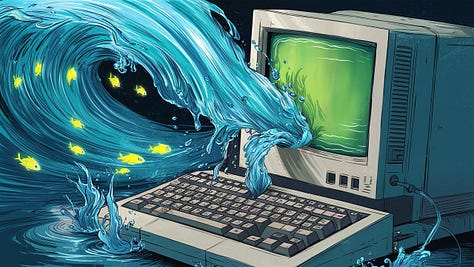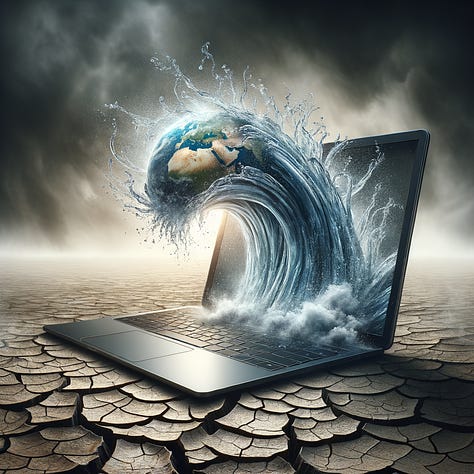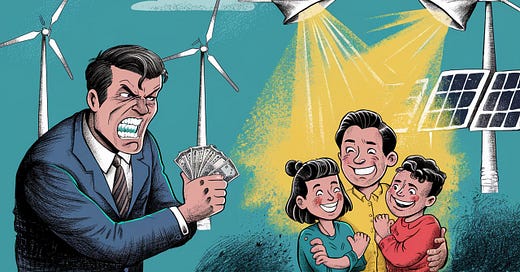They’re Giving Away Free Electricity in Europe
Plus: Can Fracking Help the Energy Transition?; Is the Internet Drying Out Chile?; and more about the real costs of renewable energy and digital tech, and how we can do better.
They’re Giving Away Free Electricity in Europe
Here’s a bit of what should be considered good news: Last month, Spain and Norway generated so much solar and wind power that producers couldn’t sell it all, and ended up giving away free electricity to more than a million customers. That was great for those consumers, great for the climate—but, as Bloomberg explains, lousy for investors and companies trying to make money from renewable energy.
As you well-informed Power Metal readers already know, there’s often a real-time mismatch between renewable electricity production and consumption, or supply and demand. Demand for electricity tends to surge in the mornings and evenings, when folks are at home, and drops during the day when they’re at work or school. The supply of solar electricity, however, usually peaks during the day, for obvious reasons. And the supply of wind is just plain erratic. The result is occasional daytime gluts that can drive wholesale prices into negative territory. Unable to sell that power at a profit, producers are forced to either shut it off or give it away.
As wind and solar capacity expand, this negative pricing effect is cropping up increasingly often. Last year there were many such episodes in Australia, California and several European countries. All of which is making power companies so nervous that they might start slowing investments in renewables.
The most obvious fix for the supply/demand mismatch is to massively scale up energy storage systems—large-scale batteries that can bank electricity when the sun is shining and the wind blowing, for use when they aren’t. But the whole issue also underlines another mismatch: that between sustainability and capitalism. Our top priority right now should be everything and anything that moves us away from dependence on fossil fuels. If we can generate so much renewable energy that it has to be given away for free, well, then, we should give it away for free. In the big picture, the benefits that might yield in terms of heading off climate change are more important than a company’s bottom line.
How We Can Do Better: Can Fracking Help the Energy Transition?
Fracking is one of the dirtiest words in any environmentalist’s lexicon. But it seems that much-loathed tool of the fossil fuel industry could help the switch to electric vehicles.
Along with oil and natural gas, fracking wells in Pennsylvania are also pulling up loads of lithium from underground. Lithium, of course, is the indispensable ingredient in batteries for everything from cell phones to electric cars. Kylie Bense of Inside Climate News reports that a recent study by the National Energy Technology Laboratory found that wastewater from the state’s hundreds of fracking wells could contain enough lithium to provide up to 40 percent of America’s current consumption. That wastewater is a mix of the fluids and chemicals used for fracking plus naturally-occurring underground water that gets pulled to the surface in the drilling process. That underground water is loaded with lithium, which probably seeped in from ash left by ancient volcanoes.
Extracting at least some of the lithium we need from liquid garbage we’re already producing is certainly an appealing alternative to getting it from water-stressed deserts in Chile or pollution-spewing mines in Australia. Still, no one knows if pulling lithium from fracking wastewater makes economic sense; at this point, there’s only one small startup that’s even trying. But the biggest worry is that the fracking industry might use the whole idea as a justification to keep on drilling for fossil fuels. It is no such thing. There are other projects underway in the US that will hopefully provide lots of relatively clean lithium in the coming years that have nothing to do with the oil and gas industries. In the meantime, though, since we’re likely to be stuck with fracking for some time, we might as well get some bonus lithium out of it.
Is the Internet Drying Out Chile?
Most of us never think about what actually makes the internet work—the planet-straddling panoply of data centers, transmission cables and other physical machinery that makes possible every email, web search, and TikTok video. We should, though, because it has a walloping environmental impact. That’s why, reports Rest of World, activists in Chile are fighting efforts by Amazon, Google, Microsoft and other tech giants to build a flock of new data centers around the capital of Santiago.
Water is their main concern. Data centers need loads of it to cool their computers, but Chile has little water to spare, being as it is in the midst of a years-long drought. So when Google recently announced plans to build a new data center in Santiago that could slurp up nearly 2 billion gallons of water each year, activists took to the streets. Under pressure, Google has agreed to reassess that center’s environmental impact, but several more are in the pipeline. At least 16 data centers have been approved for construction in the Santiago area since 2012.
Santiago isn’t the only place where Chile’s scarce water is being used to slake the world’s thirst for digital technology. The country is the planet’s second-biggest supplier of lithium. Most of it comes from Chile’s Atacama desert, where the enormous quantities of water consumed by lithium mines may be imperiling the area’s unique ecosystem and the Indigenous people who depend on it.
Data centers are also tremendous energy hogs. That’s a problem that’s only getting worse, fast, as AI systems demand ever more computing power. In the next few years, data centers may consume as much of the world’s electricity as all of Japan. We may not see the machines that power the cloud, but we’re sure going to feel their impacts.
More News Worth Knowing
Future energy demand can be met without building any new oil, gas or coal projects, says study.
Australian farmers are turning over their land to wind and solar power installations. Meanwhile in California, a solar project in the Mojave Desert is expected to destroy thousands of Joshua trees.
California coastal NIMBYs fight proposed giant battery.
Colorado just passed America’s strongest right-to-repair bill.
Not exactly news, but I did not know that some of Canada’s Indigenous communities are part owners of a proposed natural gas pipeline.
The Cutting Room Floor



PS: No Power Metal Next Week
I’m taking a little time off to celebrate a couple of milestones with my family. See you soon!







Hi Vince,
You seem to have a firm grasp of the environmental costs of scaling up renewables, but then appear to lose sight of that when you say things like "We can do better." We actually can't. It may be that you are still convinced that we are facing a problem that has a solution, rather than a predicament which only has an outcome. As a starting point, I would suggest reading the heavily referenced work of Eric Michaels that can be found here https://problemspredicamentsandtechnology.blogspot.com/
It will possibly dissuade you of any ideas about fixing things. Or not...
Definitely power generation should be socialized as we do here in BC and is done in many many countries. These are inherently monopolistic companies and cheap/free energy will only benefit every single person/industry.
As you say this really points to the unsuitability of private companies in certain fields of endeavor.